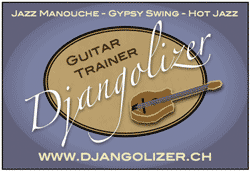
8 - The Gypsy Picking Technique
Gypsy Swing is generally played with a pick, not like Flamenco, where the strings are hit or picked with the fingers.If you play western or electric guitar for a while, you will probably get overstrained with the special Gypsy picking technique.
It can take a while (even years), until you are familiar with the new Gypsy picking technique and able to play as fast as with your common guitar picking.
If you want to play Gypsy Swing as well as other music styles, you should probably keep your old picking style.
Holding the pick
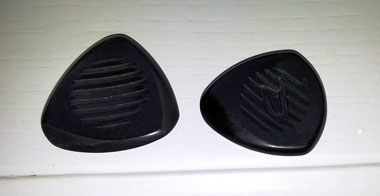
Typical Gypsy picks are quite thick, 1/10" - 1/5".
Good Gypsy picks have an angular cutting at the tip.
In contrast to the common picking technique, the pick rests on the next string, after striking down. That technique is called "Reststroke picking". After an up stroke, the pick remains in the air.
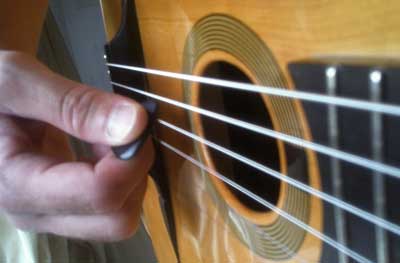
After striking down on the A-string, the pick rests on the D-string.
The angle of the pick should be about 45 degrees.
The entire forerarm, as well as the hand are not touching the guitar body.
A good position for picking the string is the right end of the sound-hole. But try also positions closer to the neck (warmer) or positions closer to the "moustache" (more metallic) to find the sound you want.
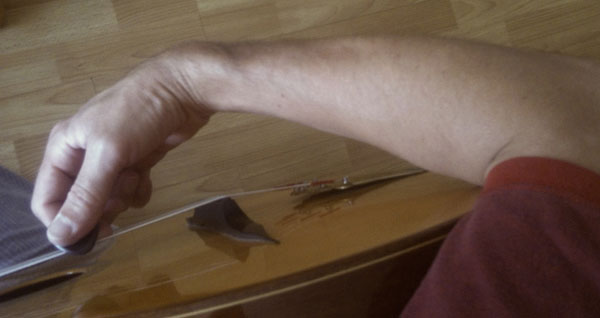
Notice that the wrist has an angle.
The strike should be done with your wrist, not by moving your forearm.
Picking rules for the down and up strokes
Beside the rule to stay relaxed, there are three rules for the Gypsy picking:
Rule #1
Make a down stroke, when you change the string.
Rule #2
Play alternate picking, when you stay on a string.
Triplets can be played down-up-down_down-up-down_down-up-down…
Rule #3
The last note of a phrase should be played with a down stroke to accentuate it.
Make a down stroke, when you change the string.
Rule #2
Play alternate picking, when you stay on a string.
Triplets can be played down-up-down_down-up-down_down-up-down…
Rule #3
The last note of a phrase should be played with a down stroke to accentuate it.
These picking rules may seem uneconomic at the first try, especially, when you play an arpeggio from the higher E-string to the lower E-string. After using this technique for a while, you will realise, that it provides a special swing feeling and the sinti demonstrate enough, that an amazing speed is possible.
Some guitar players use the standard picking for playing Jazz Manouche. I believe, that the authentic Gypsy feeling gets lost.
Please check out the following example. I bet, you will hear a clear difference between the up and the down strokes.

Basic picking exercises
First of all, keep your left hand out of the game. Just focus on the striking right hand.The following exercises are played with empty strings.
Start slowly until you get a feeling for the strokes. Use a metronom or let Djangolizer play a G6 chord ("Hungaria" first measure).
Straight and swing
Start with down strokes on the beat.At first, play the 8ths straight for a while, then play them with a swing feel.
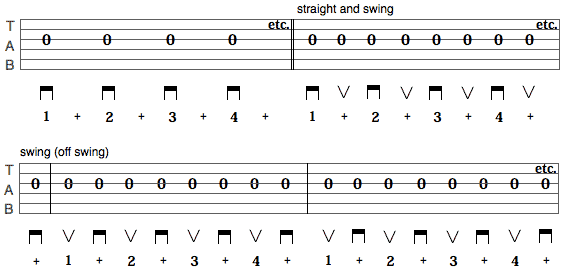
Please note: The last example starts with an upbeat. Play it with a swing feel. This off-swing feels a little bit "bumpy".
Triplets
Here a picking exercise for triplets on empty strings. Play it on all six strings.
Fingering
Below are a few picking examples involving the left hand. I didn't add hints for the fingering, because everybody prefers and uses different fingerings.Some guitar players, as Angelo Debarre, use all four fingers.
Most sinti play primarily with three fingers (index, middle, ring), but add the pinkie for difficult parts.
And there is Django's classic two-finger-play with just the index and middle finger. For some arpeggios and licks, this is the easiest and fastest way to play!
Picking-Licks
Repeating picking patterns
The following example uses a down-up-down movement, as mentioned
in the triplet example, but here it's played over swinging 8ths.You can play it over the B part of "Artillerie Lourde".
Django played part of this lick over the song "Honeysuckle Rose".
This lick has no tonality. You can try it over other songs and tonalities.
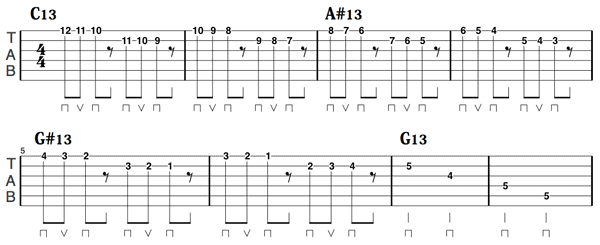
Sweep
Here an example, that breaks the first picking rule.You can play it over dominant 7th chords, respectively over their substitutes, the diminished chords. Read about substitutes in chapter "Jazz chords".
Play an upstroke for the first note and play three downstrokes in a row (sweep) over the next three notes.
In this example you play over an E7 chord the four notes of an F diminished7 chord.
Try to adapt part of it in the song "Minor Swing".
For practicing, play the picking pattern over empty strings first, and then add the left hand.
Play it straight and swinging.

The next example uses arpeggio notes only. The chord progression is the same like "Minor Swing", but with just one measure per chord.
At the first measure, you can play a sweep. A sweep means, you can play down strokes over multiple strings. Bear in mind that you keep the swing feel, while sweeping down!
At the fourth measure, you have the same arpeggio, but this time, no sweep is possible. You need to "climp" up the strings with down strokes.
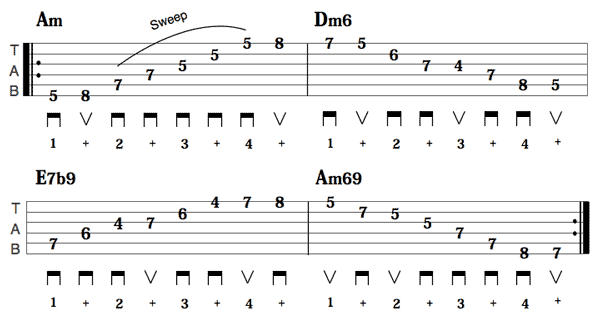
Triplets
The next example is in G major ionian, using triplets. You play three notes per string.
Djangolizer Power-User
The following example uses triplets only.It is an extract of the B-part of Lulu Reinhardts song "Lulu Swing".
Clever guys take the demo-song "Hungaria" and loop the measures 7-10, to practice this lick ;-)
Play the triplets over the E7 chord with alternate picking. This kind of fast chromatic lines are very typical in Gypsy Swing.
See also the chapter "Phrasing and Tricks"
Play the triplets over the A7 chord with the down-up-down pattern.
Use your index and middle fingers, to play this line. It is very common in Gypsy Swing, to embellish arpeggio notes with lower halftone notes.
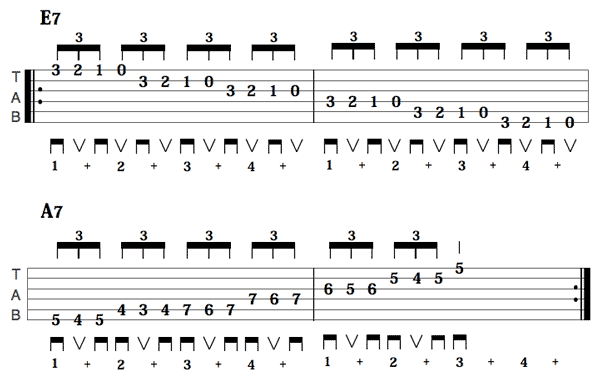
To end this chapter, I want to mention, how important it is, to practice your instrument LOUD
for sometimes. You don't need to play loud all the time, but know the
difference, how your muscles work differently. Because Gypsy Swing is
primarily acoustic music, you must work on a solid right hand technique.
Without a certain power in your strokes, you will not be heard at jamsessions (and I'm sure, that you want to be heard).
Without a certain power in your strokes, you will not be heard at jamsessions (and I'm sure, that you want to be heard).



